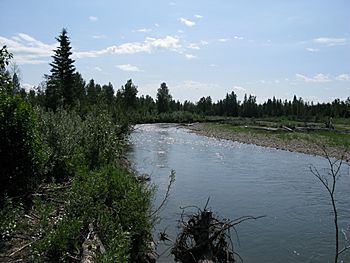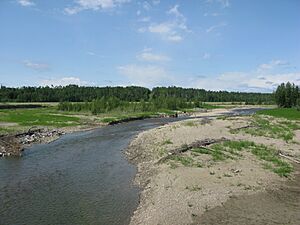James River (Alberta) facts for kids
Quick facts for kids James River |
|
|---|---|

The James River near Sundre, Alberta
|
|
| Country | Canada |
| Province | Alberta |
| Physical characteristics | |
| Main source | James Lake 1,673 m (5,489 ft) 51°43′55″N 115°25′56″W / 51.73194°N 115.43222°W |
| River mouth | Red Deer River 1,027 m (3,369 ft) 51°54′31″N 114°33′51″W / 51.90861°N 114.56417°W |
The James River is a medium-sized river located in central Alberta, Canada. It flows into the Red Deer River, making it a "tributary" or a smaller river that feeds into a larger one.
This river begins high up in the Rocky Mountains. From there, it flows towards the east until it joins the Red Deer River.
Contents
About the James River
The James River is a cool place for nature and history. It's known for its clear waters and the different kinds of fish that live there.
What Fish Live Here?
You can find several types of fish in the James River. These include brown trout, rainbow trout, mountain whitefish, and northern pike. These fish make the river a popular spot for fishing.
How the River Got Its Name
The James River, along with James Pass and James Lake, is named after an important person. This person was James Dickson, a Stoney Chief. He was a leader who signed a special agreement called Treaty 7 with the Canadian government in 1877. This treaty was an important agreement between Indigenous peoples and the government.
Roads Along the River
If you travel in the area, you'll find roads that follow the James River. The Forestry Trunk Road runs alongside much of the river's path. Also, Alberta Highway 22 crosses the James River near a small community called James River Bridge.
Tributaries of the James River

A tributary is a smaller stream or river that flows into a larger one. The James River has several tributaries that add to its flow.
Here are some of the creeks that flow into the James River:
- Bridgeland Creek
- Windfall Creek
- Willson Creek
- Sawtooth Creek
- South James River
- Parker Creek
- Teepee Pole Creek
- Stony Creek
- Burnstick Lake
- Pekse Creek

